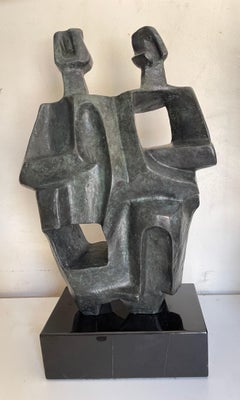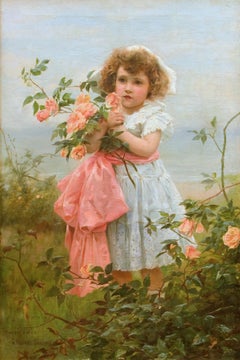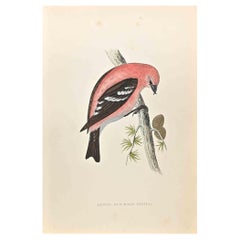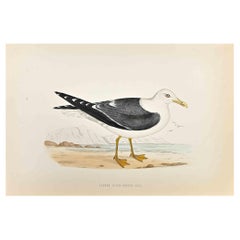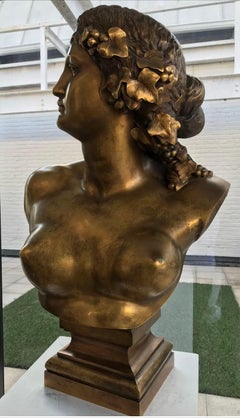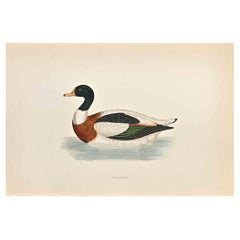1870s Art
to
191
1,186
298
91
42
47
Overall Width
to
Overall Height
to
7,526
21,094
157,221
233,654
1,955
2,242
4,854
6,366
5,757
13,026
19,153
25,446
17,925
13,702
5,359
980
125
61
3
2
1
1
1
1,014
607
5
663
366
356
342
338
290
271
177
170
170
145
88
86
66
65
61
58
57
49
47
512
421
327
299
209
39
14
10
9
8
283
1,120
978
406
Period: 1870s
Cubist Couple
Located in Los Angeles, CA
CHARNA RICKEY
"THE COUPLE"
BRONZE, SIGNED
AMERICAN, DATED 1976,
14.5 INCHES OVERALL
Recent casting
Category
Cubist 1870s Art
Materials
Bronze
Sweet Roses
Located in Mc Lean, VA
Signed and titled lower left
Category
Academic 1870s Art
Materials
Canvas, Oil
American White-Winged Crossbi - Woodcut Print by Alexander Francis Lydon - 1870
Located in Roma, IT
American White-Winged Crossbill is a modern artwork realized in 1870 by the British artist Alexander Francis Lydon (1836-1917) .
Woodcut print, hand colored, published by London, B...
Category
Modern 1870s Art
Materials
Woodcut
Lesser Black-Backed Gull - Woodcut Print by Alexander Francis Lydon - 1870
Located in Roma, IT
Lesser Black-Backed Gull is a modern artwork realized in 1870 by the British artist Alexander Francis Lydon (1836-1917) .
Woodcut print, hand colored, published by London, Bell & S...
Category
Modern 1870s Art
Materials
Woodcut
Ariane
Located in New York, NY
Exquisite patina
Signed Clesinger
Alexander Dumas described him as “one of the first sculptors of our time who knew how to soften marble and give it life “.
The Maison Marnyhac f...
Category
French School 1870s Art
Materials
Bronze
Shieldrake - Woodcut Print by Alexander Francis Lydon - 1870
Located in Roma, IT
Shieldrake is a modern artwork realized in 1870 by the British artist Alexander Francis Lydon (1836-1917) .
Woodcut print, hand colored, published by London, Bell & Sons, 1870. Na...
Category
Modern 1870s Art
Materials
Woodcut
"Croquet" John Cousins Lawrence, British, Coast, Playing in the Field
Located in New York, NY
John Cousins Lawrence
Croquet
Signed lower right and on the overlap
Oil on canvas
25 x 30 inches
Category
Academic 1870s Art
Materials
Canvas, Oil
Redstart - Woodcut Print by Alexander Francis Lydon - 1870
Located in Roma, IT
Redstart is a modern artwork realized in 1870 by the British artist Alexander Francis Lydon (1836-1917) .
Woodcut print, hand colored, published by London, Bell & Sons, 1870. Name...
Category
Modern 1870s Art
Materials
Woodcut
A portrait of a black and white spaniel dog in a sumptuous interior
Located in Bath, Somerset
A black and white spaniel standing on a yellow silk damask covered day-bed in a sumptuous interior.
Provenance:
With Arthur Ackermann & Son Ltd., London.
Anonymous sale; Christie's, South Kensington, 15 May 2007, lot 284
Private collection, London
Samuel John Carter...
Category
English School 1870s Art
Materials
Canvas, Oil
Spring - Etching by Robert Walker Macbeth - 1879
Located in Roma, IT
A finely detailed etching realized after William Fowler, showing a tranquil pastoral scene under blossoming spring trees, where cows rest or graze and a woman tends to calves.
The s...
Category
Modern 1870s Art
Materials
Etching
"Schwabelweiss" original etching
Located in Henderson, NV
Medium: original etching. Executed in 1879, this is one of the "Danube Set" of Otto Bacher's German compositions from his travels in Bavaria. Printed on laid paper and published in B...
Category
1870s Art
Materials
Etching
"Vaine Pature" etching
Located in Henderson, NV
Medium: etching (etched by Theophile Narcisse Chauvel after the Jacomin painting). Published in Paris by L'Art in 1875 and printed by Francois Lienard on laid paper. The image measur...
Category
1870s Art
Materials
Etching
Finanze - Original Lithograph by Antonio Manganaro - 1870s
Located in Roma, IT
Finanze is an original artwork realized in the 1870s by Antonio Manganaro.
Original colored lithograph
Good conditions except for yellowing of paper due to the time and some light ...
Category
Modern 1870s Art
Materials
Lithograph
Les Marché aux Chevaux de Paris... - Etching by Jules Jacques Veyrassat - 1853
Located in Roma, IT
Etching realized by Jules Jacques Veyrassat (1828-1893) after Rosa Bonheur (1822-1899).
It depicts the bustling Paris horse market, showing vigorous movement as horses are led and s...
Category
Modern 1870s Art
Materials
Etching
19th century English marine seascape, with fishing boats in the North Sea
Located in Woodbury, CT
William Thornley was a painter of coastal scenes whose work is very similar to Hubert and Charles Thornley, who may have been members of the same family. He painted scenes of genre, architecture, and landscapes as well. A number of the landscapes were of Belgium, Holland, Italy, and Norway. However, it is for his seascapes that he is best remembered.
Thornley’s works are beautifully detailed and show a masterful understanding of the moods of both weather and sea. They are often small in size and put together with fine detail and great artistic merit. Thornley’s fishing scenes are spirited and similar in style to those of “Jock” Wilson, and are often painted in pairs. Thornley’s works have always been popular when they appear on the art market.
He was believed to have first exhibited marines at the Royal Academy in 1859 from an address in Paddington, London and also at the British Institution from 1861 until it closed in 1867. He continued to exhibit at the Royal Academy until 1898.
Thornley also exhibited at the Paris Salon and the Salon of French Artists, receiving an honorable mention in 1881 and a third-place medal in 1888.
William Thornley also went by the names Georges William and William...
Category
Victorian 1870s Art
Materials
Canvas, Oil
Still Life with Flowers in a Vase
Located in Milford, NH
A fine 19th century still life of flowers by French artist Louis Mettling (1847-1904). Mettling was born in Dijon, Côte- d'Or, France to English parents. He studied at the École des ...
Category
Realist 1870s Art
Materials
Canvas, Oil
Four Pheasants
By Joseph Wolf
Located in London, GB
WOLF, Joseph (artist)
Four Pheasants
London, For the author, Red Lion Court, Fleet Street, 1871
Four original hand-coloured lithographic plates by Joseph Smit after Joseph Wo...
Category
Naturalistic 1870s Art
Materials
Watercolor, Gouache, Lithograph
Large river edge with birds in France
By Edmond Yon
Located in BELEYMAS, FR
Edmond YON
(Montmartre 1841 – Paris 1897)
Riverbank with birds
Oil on canvas
H. 79.5 cm; L. 130 cm
Signed lower right and dated 1876
Original frame
Exhibition: 1876, Salon des Artis...
Category
French School 1870s Art
Materials
Canvas, Oil
Le Clocher de St. Nicolas
Located in New York, NY
A very good impression of this scarce lithograph on wove paper. , Printed by Lemercier & Cie, Paris and published by Alfred Robaud. From "Douze Croquis et Dessins Originaux."
Catalo...
Category
Realist 1870s Art
Materials
Lithograph
Olivia Unveiling to Viola (from Twelfth Night)
Located in Mc Lean, VA
Exhibited:
Birmingham Royal Society of Artists, 1879
“Autumn Exhibition of the Birmingham Royal Society of Artists.” The London Times, 25 August 1879. T...
Category
Academic 1870s Art
Materials
Canvas, Oil
Shere, Surrey, 19th century landscape oil on canvas
Located in Hillsborough, NC
Lovely landscape painting of sunset titled Shere, Surrey by George Vicat Cole, RA (1833-1893). The painting is in the tradition of plein art, monogrammed VC lower right and dated 187...
Category
English School 1870s Art
Materials
Canvas, Oil
$1,592 Sale Price
20% Off
"L'Incendie" original etching
Located in Henderson, NV
Medium: original etching. This is a rich, dark impression on laid paper with full original margins, printed by A. Salmon and published in Paris by L'Art in 1876. Size: 9 1/2 x 10 7/8...
Category
1870s Art
Materials
Etching
SAPPHO, DAUNTLESS and GRACIE Racing at Cape May 1871
Located in Costa Mesa, CA
James E. Buttersworth's most sought-after artworks emerge from his depictions of American racing yachts going head to head in the major regattas...
Category
American Realist 1870s Art
Materials
Canvas, Oil
"Fin d'Ete" etching
Located in Henderson, NV
Medium: etching (after the painting). Etched by Charles Courtry after Carolus Duran. This impression on laid paper was printed by A. Salmon and published in Paris for "L'Art" in 1875...
Category
1870s Art
Materials
Etching
Antique 19th Century Swiss School Pastel Portrait Painting Beautiful Young Girl
Located in Portland, OR
A enchanting & intimate 19th century Swiss pastel portrait painting of a beautiful young girl, circa 1870, attributed to the celebrated Swiss artist Albert Anker (1831-1910).
The pai...
Category
Realist 1870s Art
Materials
Pastel, Paper
Une Lecture chez Diderot - Etching by Auguste Mongin - 1878
Located in Roma, IT
Etching and drypoint realized by Auguste Mongin in 1878, after Meissonier.
Early proof before the letter, with the stamp of the publisher Petit.
The subject was published on the Ma...
Category
Modern 1870s Art
Materials
Etching
Mountain Goat
Located in Missouri, MO
Jules Moigniez
"Mountain Goat"
Bronze
approx 11 x 9 x 4 inches
Signed
Jules Moigniez (1835-1894)
Jules Moigniez was born in Senlis sur L'Oise, France ...
Category
Realist 1870s Art
Materials
Bronze
William Astor's Schooner AMBASSADRESS Leads the Regatta
Located in Costa Mesa, CA
William Astor Pilots the New York Yacht Club Run
A superior and graceful schooner as grand as any ever built, AMBASSADRESS was William Backhouse Astor, Jr's "floating home" from its launch in 1877 until he sold it in 1884 and purchased his massive steam/sail yacht...
Category
American Realist 1870s Art
Materials
Canvas, Oil
French Moonlit Landscape with Brushwood Gatherer (1872)
Located in Stockholm, SE
Under a softly luminous night sky, an elderly peasant gathers a bundle of brushwood amid the quiet fields of rural France. This tranquil nocturne is the subject of Alfred Wahlberg’s ...
Category
Impressionist 1870s Art
Materials
Oil, Wood Panel
Bulls Fighting /// Antique Victorian Animal Landscape Etching Landscape Horse
By James Ward
Located in Saint Augustine, FL
Artist: (after) James Ward (English, 1769-1859)
Title: "Bulls Fighting"
Portfolio: The Portfolio
*Signed by Wise in pencil lower right. It is also signed in the plate (printed signat...
Category
Victorian 1870s Art
Materials
Laid Paper, Etching, Intaglio
Bouquet de Fleurs" par Eugène Cauchois (1850-1911)
Located in GOUVIEUX, FR
"Bouquet of Flowers" by Eugène Cauchois (1850–1911)
• This magnificent painting, measuring 67 x 83 cm (38 x 56 cm without frame), depicts a richly detailed bouquet of flowers painte...
Category
1870s Art
Materials
Oil
Studies of Sheep and Goat Heads, Cairo (c. 1871)
Located in Stockholm, SE
This sheet features four close-up studies focusing on the heads of goats or sheep. Each animal’s head is drawn from a different angle: one profile highlights a pair of curved horns, ...
Category
Realist 1870s Art
Materials
Paper, Watercolor
Seascape - 19th Century Impressionist Antique British Moonlit Sea Painting
Located in Sevenoaks, GB
A beautiful signed and dated 1875 impressionist oil on board depicting a calm sea with a hazy light breaking through the clouds.
Excellent quality work, signed with initials and pre...
Category
Impressionist 1870s Art
Materials
Oil
Antoine Louis Barye Dromadaire D’Algerie Camel
Located in Dallas, TX
Antoine-Louis Barye
Dromadaire d'Algérie Circa. 1874
First offered in Barye's 1862 catalogue under the title Dromadaire d'Égypte, the present study became known as Dromadaire d'Alg...
Category
1870s Art
Materials
Bronze
Pair of Neoclassical Terracotta Bust of Emperor Caracalla and Cicero
Located in Rome, IT
Pair of 19' century Italian Marble imitation painted Terracotta .
Bust of Emperor Caracalla and Cicero .
Measurements : cm 71 H x 60
Available also a pair marble imitation colum...
Category
Academic 1870s Art
Materials
Terracotta
$11,382 Sale Price
20% Off
Pastoral Landscape
Located in Milford, NH
A fine pastoral landscape by Irish artist Edward B. Gay (1837-1928). Gay was born in Dublin, Ireland, and emigrated with his to Albany, NY at a very young age as a result of the pota...
Category
American Impressionist 1870s Art
Materials
Canvas, Oil
Classical Ruins
Located in Miami, FL
William Louis Sonntag Sr. was an American Landscape painter and a member of the Hudson River School movement. He was an Academician of the National Academy of Design. His work is in ...
Category
Old Masters 1870s Art
Materials
Oil
$12,800 Sale Price
20% Off
Sortie du Port de Honfleur - Etching by Johan B. Jongkind - 1864
Located in Roma, IT
Etching on laid paper
Signed and dated in plate lower left: Jongkind 1864
Published by Cadart & Luquet, Éditeurs, 79 Rue Richelieu, Paris
With the blindstamp of the Société des Aquaf...
Category
Modern 1870s Art
Materials
Etching
original etching
Located in Henderson, NV
Medium: original etching. Printed in 1875 on laid paper at the Alfred Salmon Imprimerie and published in Paris by L'Art. Plate size: 8 1/2 x 11 inches (215 x 278 mm). Signed in the p...
Category
1870s Art
Materials
Etching
Antique Dog Lithograph, Taste of Alfred De Dreux, France circa 1870 Greyhounds D
By Alfred de Dreux
Located in SANTA FE, NM
Antique Dog Portrait
Lithograph in the Taste of Alfred De Dreux
Greyhounds D
France, circa 1870
Lithography
25 5/8 x 19 5/8 (28 x 20 frame) inc...
Category
Romantic 1870s Art
Materials
Lithograph
Silver birches, Provence: luminous landscape painting 19C French painting
Located in Norwich, GB
A wonderful work by Provençal master Joseph Collas, a native of Aix en Provence in the South of France. Born in 1841, Collas studied with Emile Loubon - who was also known for his pa...
Category
French School 1870s Art
Materials
Canvas, Oil
"Vaine Pature" etching
Located in Henderson, NV
Medium: etching (etched by Theophile Narcisse Chauvel after the Jacomin painting). This impression on laid paper was printed by Francois Lienard in 1875 and published in Paris for L'...
Category
1870s Art
Materials
Etching
Le Bain - Etching by Charles Chaplin - 1870s
Located in Roma, IT
Le Bain is an artwork realized by Charles Chaplin in the 1870s.
Etching.
Image size:23x13
Good conditions.
Realized for the "Société des Aquafortistes. Born on the initiative o...
Category
Modern 1870s Art
Materials
Etching
Portrait of a Young Girl with a Dove
Located in Saint-Ouen, FR
Lacazette Amelie (19th)
Young Girl with a dove
Oil on canvas signed upper left
Old frame gilded with leaves
Dim canvas : 56 X 37 cm
Dim Frame : 74 X 57 cm
Lacazette Amelie (19th) -
...
Category
Academic 1870s Art
Materials
Oil
Large Antique American Hudson River School Waterfall Landscape Rare Oil Painting
Located in Buffalo, NY
Antique American rare woman artist Hudson River School waterfall landscape by Susan E. W. Fuller (1831 - 1907). Oil on canvas. Signed. Large and impressive painting. Handsomely fr...
Category
Hudson River School 1870s Art
Materials
Canvas, Oil
British 19th century Victorian Ruined Castle by the shore with fishing boats
Located in Woodbury, CT
Wonderful Antique Victorian Welch landscape, Ruined Castle by the shore side with moored fishing boats
Joseph Horlor was born in Bath in 1809 and was a landscape painter of Welsh sc...
Category
Victorian 1870s Art
Materials
Canvas, Oil
Souvenir - Etching by Adolphe Appian - 1870s
Located in Roma, IT
Souvenir is a black and white etching realized by Adolphe Appian (1818–1898) in 1870s.
Titled in the lower.
Image size: 23.5cmx13cm.
Very Good condition.
Realized by Cadart for t...
Category
Modern 1870s Art
Materials
Etching
Studies of Goats and Sheep, Cairo (c. 1871)
Located in Stockholm, SE
Swedish artist Egron Lundgren sketched a small herd of goats and sheep resting together in this scene. Two goats recline quietly at the center while another stands nearby, creating a...
Category
Academic 1870s Art
Materials
Paper, Watercolor
Novembre
Located in Roma, IT
Signed the plate with the artist's monogram “TS”lower left. Inscription “C. Lovera imp” lower right. Very rare print from “L'Art in Italia”, 1871.Original Prints.
Image Dimensions : ...
Category
Realist 1870s Art
Materials
Etching
Bords du Sornin - Etching by Armand Charnay - 1860s
Located in Roma, IT
Bords du Sornin is an artwork realized by A.Charnay in the 1870s.
Etching.
Image size:19x29
Good conditions.
Realized for the "Société des Aquafortistes. Born on the initiative...
Category
Modern 1870s Art
Materials
Etching
(Paysage) etching
Located in Henderson, NV
Medium: etching (after the painting). Etched by a French engraver after the Corot painting. Published in Paris in 1873 by the Galerie Durand-Ruel for the rare "Recueil D'Estampes Gra...
Category
1870s Art
Materials
Etching
Cigale
Located in PARIS, FR
Cigale (Cicada)
by Albert-Ernest CARRIER-BELLEUSE (1824-1887)
Bronze sculpture with nuanced dark brown patina
signed "A. Carrier-Belleuse"
old edition cast
France
circa 1870
heigh...
Category
French School 1870s Art
Materials
Bronze
"Un Grain à Trouville" (Squall at Trouville) from L'Illustration Nouvelle
Located in Soquel, CA
"Un Grain à Trouville" (Squall at Trouville) from L'Illustration Nouvelle
Dramatic etching of an approaching storm by Félix Hilaire Buhot (French,...
Category
Barbizon School 1870s Art
Materials
Laid Paper, Etching, Aquatint
Spring - Original Etching by Telemaco Signorini - 1873
Located in Roma, IT
Landscape and figures. Signed on plate.
Image Dimensions : 15x21 cm.
Publisher : Editore Lovera
Excellent conditions
This artwork is shipped from Italy. Under existing legislation, ...
Category
Realist 1870s Art
Materials
Etching
Studies of Goat Heads and Figures, Cairo (c. 1871)
Located in Stockholm, SE
Here Lundgren concentrates on individual studies of goats, especially their heads and expressions. In one sketch, a goat faces forward, its distinctive long ears and gentle features ...
Category
Realist 1870s Art
Materials
Paper, Watercolor
Veduta del Castello dell'Acqua Felice... Etching by Giovan B. Piranesi - 1875
Located in Roma, IT
Etching realized by Giovan Battista Piranesi in 1875.
Image dimension: 40.5x52 cm.
Sheet dimension 68.5x74.3 cm.
Signed on the plate lower right. Plate from Views of Rome. Excell...
Category
Modern 1870s Art
Materials
Etching
The Sterculaceae - Lithograph by Vincenzo Tenore - 1870s
Located in Roma, IT
Lithograph hand watercolored.
Plate from "Atlante di Botanica popolare ossia Illustrazione di Piante Notevoli di ogni famiglia" (Atlas of popular botany or illustration of notable p...
Category
Modern 1870s Art
Materials
Lithograph
Contemplation
Located in Middletown, NY
This is an engaging work with masterful detail that will unfold for an intent viewer, particularly in the area of the figure's well-worn hands, and her traditional clothing. The image depicts a Bavarian woman deep in thought while winding a skein of wool. She is seated outside of her home, where she has brought her yarn swift...
Category
English School 1870s Art
Materials
Watercolor, Handmade Paper
19th century British Marine School, ship in rough seas, with setting Sun
By Bernard Benedict Hemy
Located in Woodbury, CT
19th century British oil, Ship in a rough sea.
The style of the painting is very similar to the work of Bernard Benedict Hemy a well known Briti...
Category
Victorian 1870s Art
Materials
Canvas, Oil
$1,560 Sale Price
20% Off
“Seaside Cliffs, California”
Located in Southampton, NY
Beautiful original pastel on archival card stock from Paris of the craggy seaside cliffs of California by the well known Hudson River artist, George Douglas Bremerton. Signed lower left. Circa 1880. Condition is excellent. Under glass. The artwork is housed in its original ornate scroll designed frame. Overall framed measurements are 33 by 19 inches. Provenance: A East Coast Florida estate.
George Douglas Brewerton received lessons in art from Prof. Robert W. Weir at West Point where his father was Superintendent. In 1874, he was detailed to San Francisco as an officer in the Stevenson Regiment. In 1848, he underwent many adventures in Western deserts and mountains with Kit Carson, who crossed the country with news of the California Gold Rush. After serving as an aide to Gen. Rufus Saxton during the Civil War, Brewerton called himself “Colonel,” although he never received an army commission...
Category
Hudson River School 1870s Art
Materials
Pastel, Archival Paper
$2,240 Sale Price
20% Off
